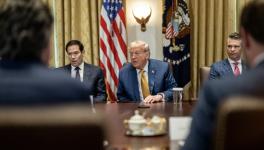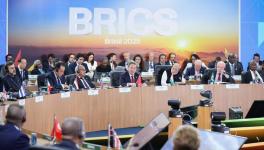Turbulence in the Global Economy

IMF briefing. Photo: IMF News
On April 22, 2025, the International Monetary Fund (IMF) released its annual World Economic Outlook report, which has a quiet but decisive subtitle: A Critical Juncture and Policy Shifts. The report, once more a hefty piece of work by the IMF economists and their associates, rushes to make sense of the tariffs first threatened by US President Donald Trump and then delayed, and then, as if the flurry was not sufficient, retained and increased against China. The IMF attempts to make the case that through 2024, “global growth was stable” and that the current downgrade to global growth is largely a factor of the Trump tariff “uncertainty” and “unpredictability”.
The IMF releases this report during the annual week of meetings of the Fund and the World Bank. At the start of the meetings, IMF Director Kristalina Georgieva reflected on the situation in the global economy and claimed that the turbulence is largely due to “an erosion of trust”. No longer, she said, do countries trust each other as they once did, nor do they trust the international system. Apart from the reversal of the tariffs, the IMF says that what needs to be built once more is trust in international economic affairs.
Whispers in the corners of the IMF and World Bank meetings are all about the irrationality of the Trump administration, and – in particular – the unpredictability of Trump’s own statements. With the head of the North Atlantic Treaty Organisation (NATO) beside him, Trump told a press conference in the White House that Canada is not a real country but would be an excellent state within the United States. That sort of comment creates fodder for the hushed giggles at the edges of this meeting, when otherwise serious men and women in business suits maintain a rictus look of concern for high affairs of state.
Errors in judgment
One of the significant errors in the assessment by the IMF is that everything in the Western economies had begun to look stable last year. While it is true that the threat of the tariffs and then the anti-China tariffs themselves created “a major negative shock to growth”, it is not true that growth rates had been expected to reach new heights this year.
Growth in the US has been significantly below its historic trend since the 2007-08 subprime mortgage crisis-induced financial crisis – indeed, US growth since then has been cumulatively lower than in the Great Depression. In the 17 years after the Great Crash of 1929, US annual GDP growth averaged 3.7%, whereas in the 17 years since the International Financial Crisis, US annual growth averaged only 2.0%.
In October 2024, the IMF projected that the United States would grow at 2.2%, and since reduced its forecast to 1.8%. Meanwhile, in October last year, it suggested a rate of 4.5% for China and 6.5% for India, far higher than for either the US projected rate or the advanced economy projections (1.8%). The Trump tariffs certainly compounded the problems for the US, but they are not the cause of the problem. Sluggish growth has been the situation for almost two decades.
On that sluggishness, the IMF’s new World Economic Outlook is remarkably bland. It suggests that the “core macroeconomic policy challenge” of the United States is its federal government debt. This debt, which is 36.2 trillion, is 124% of GDP. Ten global north countries are in the twenty countries with the highest debt-to-GDP ratios: Japan (266%), Greece (193%), Italy (151%), United States (124%), Portugal (122%), Spain (117%), France (112%), Belgium (111%), Canada (109%), and the United Kingdom (105%). Cutting the deficit might make good macroeconomic sense, but it does not by itself propose a way back to growth for the United States. Lower social welfare spending will further deplete private consumption. And Trump’s dream of revitalizing US manufacturing is not going to work merely through a reduced federal government deficit without a massive, massive release of resources for industrialization. Without an attack on living standards, this could only come from measures such as a reduction in excessive US military expenditure or reform of the country’s grotesquely inefficient private health system. These are policies Trump will not adopt.
In fact, the IMF gives notoriously poor advice to the Chinese government. It suggests that China should emulate the United States rather than the other way around. China, the IMF says, should “boost chronically low private consumption” and “dial back industrial policies and pervasive state involvement in industry”. In other words, abandon its long-term growth profile and become like the slow-growing United States!
In November 2024, the IMF released an interesting paper by its economists (Dirk Muir, Natalija Novta, and Anne Oeking) called “China’s Path to Sustainable and Balanced Growth”. The paper and the World Economic Outlook together make the case that China’s strong economic performance comes from its COVID stimulus, its high exports, a high domestic savings rate to finance public infrastructure, its banking system that directs liquidity to small and medium-sized enterprises to generate productive activity rather than property speculation, and an emphasis on high-quality productive forces. This is a fairly good summary of the structure of Chinese growth over the last period. But it is totally counter to the suggestions that the IMF then gives to China: which is to liquidate everything that allowed it to stave off the long term sluggishness of the advanced industrial countries (including to pressure the renminbi to appreciate, as the US would like so that its trade imbalance can be rectified by a foreign exchange shift rather than by greater productivity in the US itself).
The IMF is right. There is great uncertainty ahead. But there is also certainty in its own reports and in its charts. High domestic savings and better sovereignty of resources (including the financial system), alongside canalization of these finances to the productive sector (for infrastructure and industrialization), produce more stability in the long run than an excessive reliance on private financial markets and the whims of the billionaire class. But the IMF does not close its new report with that news. It prefers to look out of the window and see the storms in the Western skies rather than the calm in the East.
Vijay Prashad is an Indian historian, editor, and journalist. He is a writing fellow and chief correspondent at Globetrotter. He is an editor of LeftWord Books and the director of Tricontinental: Institute for Social Research. He has written more than 20 books, including The Darker Nations and The Poorer Nations. His latest books are On Cuba: Reflections on 70 Years of Revolution and Struggle (with Noam Chomsky), Struggle Makes Us Human: Learning from Movements for Socialism, and (also with Noam Chomsky) The Withdrawal: Iraq, Libya, Afghanistan, and the Fragility of US Power.
This article was produced by Globetrotter.
Courtesy: peoples Dispatch
Get the latest reports & analysis with people's perspective on Protests, movements & deep analytical videos, discussions of the current affairs in your Telegram app. Subscribe to NewsClick's Telegram channel & get Real-Time updates on stories, as they get published on our website.






















